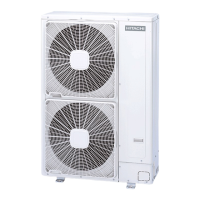3. Piping work and refrigerant charge
56
SMGB0079 rev.0 - 01/2013
3.2 Piping connection for outdoor unit
3.2.1 RAS-(2-2.5)HVNP / RAS-3HVNC
1 Take the piping cover away from the unit. Then fetch the pipes through the rear side and route piping according to the
installation place as shown in the gure. Make holes by cutting along the guideline at the rear of the cover or punching
with a driver. Remove the burr with a cutter, and place a insulation (eld supplied) to protect cables and pipes.
Pipe cover
Rear side
piping
Stop valve
Direction to remove pipe cover
Connecting
piping
2 Attach the pipe cover in order to prevent rainwater from entering inside the cabinet.
3 Use a pipe bender for pipe bending work when connecting pipes.
4 Check to ensure that the stop valves are completely closed before connecting pipes.
5 Connect the eld supplied refrigerant pipes to the indoor unit and outdoor unit. Apply the oil thinly at the seat are nut
and pipe before tightening.
The required tightening torque is as follows:
Pipe Size Tightening Torque (Nm)
Ø 6.35 mm (1/4) 20
Ø 9.52 mm (3/8) 40
Ø 12.70 mm (1/2) 60
Ø 15.88 mm (5/8) 80
Ø 19.05 mm (3/4) 100
Use two spanners
here for pipe con-
nection
Do not work with
two spanners
here.
Refrigerant
leakage shall
occur
6 After connecting the refrigerant piping, seal the open space between knockout hole and refrigerant pipes by using
insulation material.
Unit Side
Nº Description
Insulation Material
Insulation Material
Field Supplied
Insulation Material
7 Operation of stop valve should be performed according to the Outdoor unit stop valve explanation.

